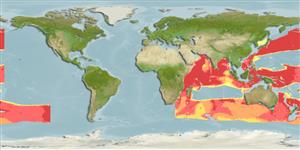Teleostei (teleosts) >
Lophiiformes (Anglerfishes) >
Oneirodidae (Dreamers)
Etymology: Oneirodes: Greek, 'oneiros' = a dream or dreamlike or out of a dream (suggesting this fish is so strange and marvelous that can exist only in dreams) (Ref. 86949).
More on authors: Regan & Trewavas.
Environment: milieu / climate zone / depth range / distribution range
Ecology
Marine; bathypelagic; depth range 1750 - 3800 m (Ref. 86949). Deep-water
Indo-West Pacific.
Size / Weight / Age
Maturity: Lm ? range ? - ? cm
Max length : 7.0 cm SL male/unsexed; (Ref. 36336)
Short description
Identification keys | Morphology | Morphometrics
Dorsal soft rays (total): 5 - 6; Anal soft rays: 4. Characterized by having escal morphology: anterior escal appendage bearing a distal cluster of filaments; absence of medial escal appendages; simple posterior appendages, unusually long and slender; absence of lateral and anterolateral escal appendages; no indentation on posterolateral margin of subopercle; length of ventral fork of opercle; 28.2-28.6% SL; ratio of lengths of the dorsal and ventral forks of opercle 0.48-0.56; absence of epibranchial teeth; presence of teeth on pharyngobranchial II; upper jaw teeth 17-42, lower jaw teeth 25-48; teeth on vomer 4-7; dorsal fin rays 5-6; anal fin rays 4; pectoral fin rays 14-15; head length 40.9-46.4% SL; head depth 37.0-46.4% SL; premaxilla length 32.3-37.0% SL; length of lower jaw 45.8-50.0% SL; length of illicium 19.3-25.0% SL (Ref. 86949).
Life cycle and mating behavior
Maturity | Reproduction | Spawning | Eggs | Fecundity | Larvae
Orr, J.W., 1991. A new species of the ceratioid anglerfish genus Oneirodes (Oneirodidae) from the western North Atlantic, with a revised key to the genus. Copeia 1991(4):1024-1031. (Ref. 36336)
IUCN Red List Status (Ref. 130435: Version 2024-2)
Threat to humans
Harmless
Human uses
Fisheries: of no interest
Tools
Special reports
Download XML
Internet sources
Estimates based on models
Preferred temperature (Ref.
123201): 1.8 - 3.3, mean 2.2 °C (based on 870 cells).
Phylogenetic diversity index (Ref.
82804): PD
50 = 0.5000 [Uniqueness, from 0.5 = low to 2.0 = high].
Bayesian length-weight: a=0.01995 (0.00906 - 0.04395), b=3.01 (2.83 - 3.19), in cm total length, based on all LWR estimates for this body shape (Ref.
93245).
Trophic level (Ref.
69278): 3.7 ±0.6 se; based on size and trophs of closest relatives
Resilience (Ref.
120179): High, minimum population doubling time less than 15 months (Preliminary K or Fecundity.).
Fishing Vulnerability (Ref.
59153): Low vulnerability (10 of 100).
